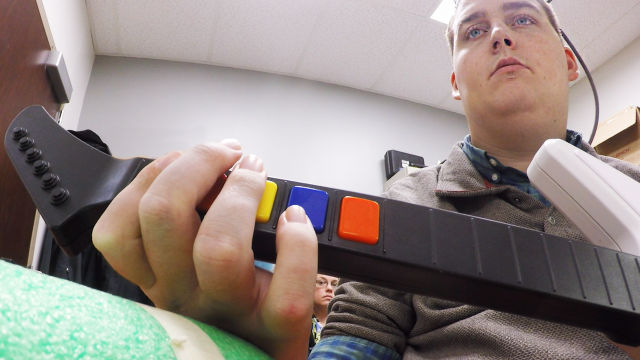
Gentlemen. We can rebuild him. We have the technology. Researchers have used what they call a neural bypass to replace the link between a quadriplegic man’s mental commands and the muscles in his limbs. Ian Burkhart was involved in a driving accident, and six years later he’s able to move his own hand once more. The neural bypass allows him to move his individual fingers, pick up large or small objects, swipe a credit card or even play Guitar Hero. He is the first patient to ever undertake this treatment.
Burkhart said during a press conference, that his ability to execute relatively complex types of movement “really can translate into a lot of functional, daily tasks that I can’t do on my own right now.”
“So that’s something that, if or when I can use this system outside of the clinical setting, it will really increase my quality of life and my independence, and decrease the amount of assistance I need from other people.”
Here’s how it works: a microelectrode array is implanted into Burkhart’s brain. It detects the activity in a particular region of his left motor cortex, a region which the researchers had already analysed with functional magnetic resonance imaging, determining that it was the area that controlled his hand – when Burkhart repeatedly thought about moving his hand, this region would increase in activity.
The microelectrode array is hooked into the researchers’ neural bypass system, which receives Burkhart’s brain signals and uses machine learning algorithms to determine what these signals mean. The deciphered signals are then used to control the 130 muscle-stimulating electrodes within a flexible arm sleeve.
15 months after the procedure, and three practice sessions per week later, he can control six types of hand and wrist movements with the power of his mind.
Video from CBS News:
“The ability to move individual fingers—we were not sure if this would be possible,” said first author Chad Bouton, from the Feinstein Institute for Medical Research. “This result really exceeded our expectations because not only were we able to find those signals in the brain and decipher those signals for that individual finger movement, but we were able to link those signals to Ian’s muscles and allow that kind of movement to be regained.”
“This technology has evolved rapidly over the past decade,” said coauthor Ali Rezai from Ohio State University. “It may be coming of age at this point.”
The researchers believe that more needs to be done to allow it to be used to aid patients suffering from other forms of parallysis, and for patients to be able to use the tech in their daily lives.
“And now within two years since then, things are moving along even better than I imagined,” said Burkhart, optimistically referring to the very first time he was able to move his hand after the accident. The technology is moving along quite briskly indeed.
Sources: Ars Technica, NBC News
This article (Paralyzed Man can Move Arm Again Thanks to Synthetic Nervous System) is a free and open source. You have permission to republish this article under a Creative Commons license with attribution to the author(CoNN) and AnonHQ.com.




